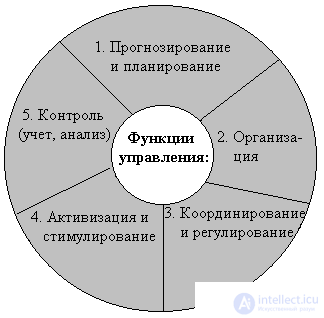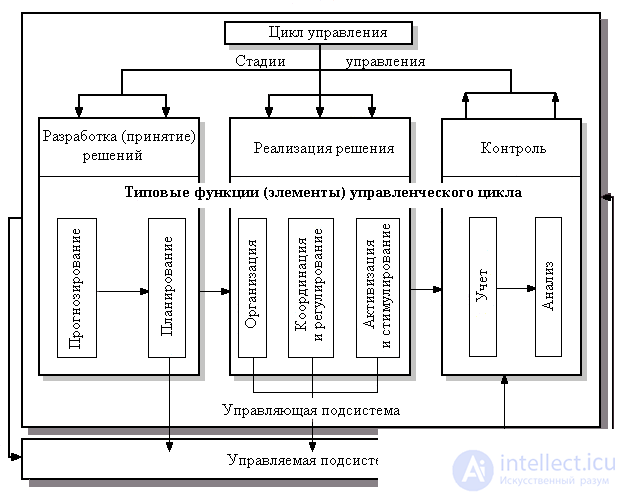Lecture
At present, in the definition of functions, in their differentiation and integration, the historically established contradiction is preserved. First of all, the very concept of “control function” is given a different meaning, by virtue of which heterogeneous grounds (criteria) are chosen for their selection. Classifications, lists (even with the uniformity of criteria) differ on the number of functions allocated, the degree of their consolidation, etc.
What should be understood by management functions? Where is the criterion for their differentiation and what should be their classification?
We formulate the original position. In functions the essence, the content of management is shown. In the management of the unity of the two sides - the process and structure - its content is revealed in the process. Hence, the control function is the control process function.
A function is an objective component of management, such a part of management as a whole, the manifestation of which is a condition for the manifestation of this whole. This expresses the systems approach * to the formation of the concept and structure of management functions.
Management * - the cumulative implementation of functions. The objective set (composition) of functions is inherent in management at any hierarchical steps, for any features of production. From here - qualitative homogeneity of management at any levels.
The whole huge, complex (diverse) set of management actions - at any level and in any system - can be reduced to a limited list of relatively strictly localizable functions that make up a closed loop control [1]:
It is interesting that almost all researchers fully share this view on the composition of the management cycle, but only apply to management technology, which is not associated with its essence, and therefore with functions.
Each of the management functions may be further differentiated. In tab. 3. 1 offers one of the possible options, in our opinion preferred.
T a b l and c a 3. 1
Classification of management functions
|
Stages of management |
Control functions |
|
The concept of management decisions |
Forecasting Planning |
|
Solution implementation |
Organization Coordination and regulation Revitalization and stimulation |
|
Control |
Accounting Analysis |
It would not be accurate to rank the control functions; in importance (it is often necessary to meet, for example, statements about the special importance of the decision-making function or the planning of the central control function). It is more fair to assume that at different levels of the hierarchy, in time and depending on the specific conditions of production, the value of the function varies.
With a certain logical sequence (order) in the implementation of functions, they practically interpenetrate. So, for example, accounting and analysis, which would seem to complete the management cycle, actually give impulses to planning (correction), regulation, activation, etc. in combinations that are different in advance of time, power of action, etc. (Fig. 3). one).

Fig. 3. 1. Management functions.
A schematic expression of the main relationships between control functions is shown in Fig. 3. 2.

Fig. 3. 2. Communication and interaction of functions.
By virtue of the unity of the process and the management structure, the management functions should be considered in relation to and in relationship with the functions of the apparatus.
Practically, the implementation of management functions at a specific economic facility is related to the performance of tasks that the corresponding management apparatus is intended to solve. More precisely, they should be defined as service tasks or as functions-tasks of the management apparatus.
The composition of task functions, as well as the apparatus itself (structure), is determined by the characteristics of the control object, which has a formative effect on them (certainly, in combination with the influence of control functions). Depending on the features of the object, the outfit with the functions of controlling the object as a whole, can be distinguished functions-tasks of individual units of the apparatus:
The unity of the process and the management structure is expressed in the interpenetration of management functions and task functions that are solved in the management apparatus: the performance of each task function involves the implementation of all management functions, being, in turn, a way to implement them.
The proposed classification makes it possible to introduce certainty in some aspects of management theory and can serve as a methodological basis for solving practical problems of improving the management of economic facilities. Taking this approach into account, for example, ways of improving the management structure, methodological bases for creating automated enterprise management systems, etc. should be considered.
Comments
To leave a comment
Management
Terms: Management